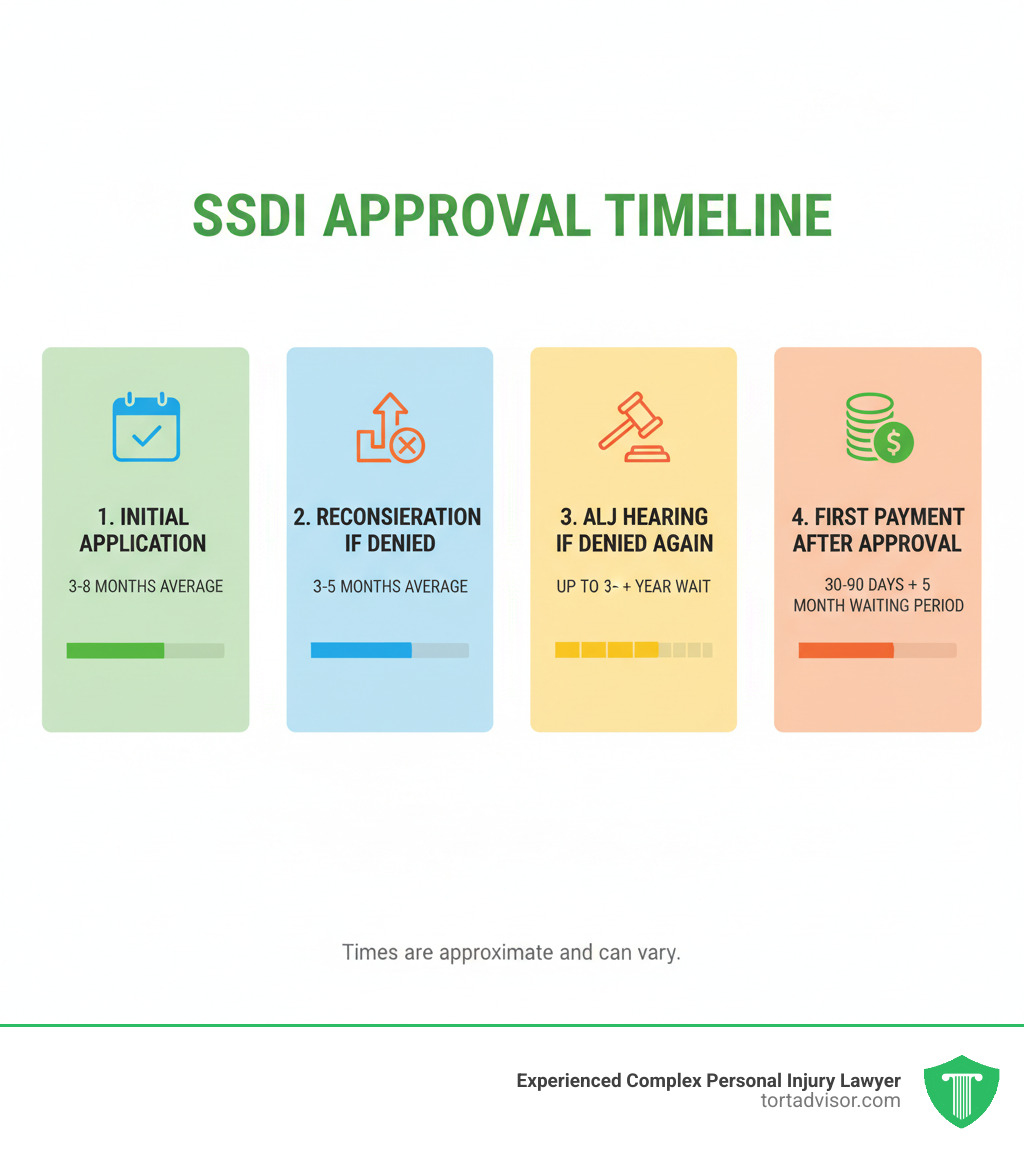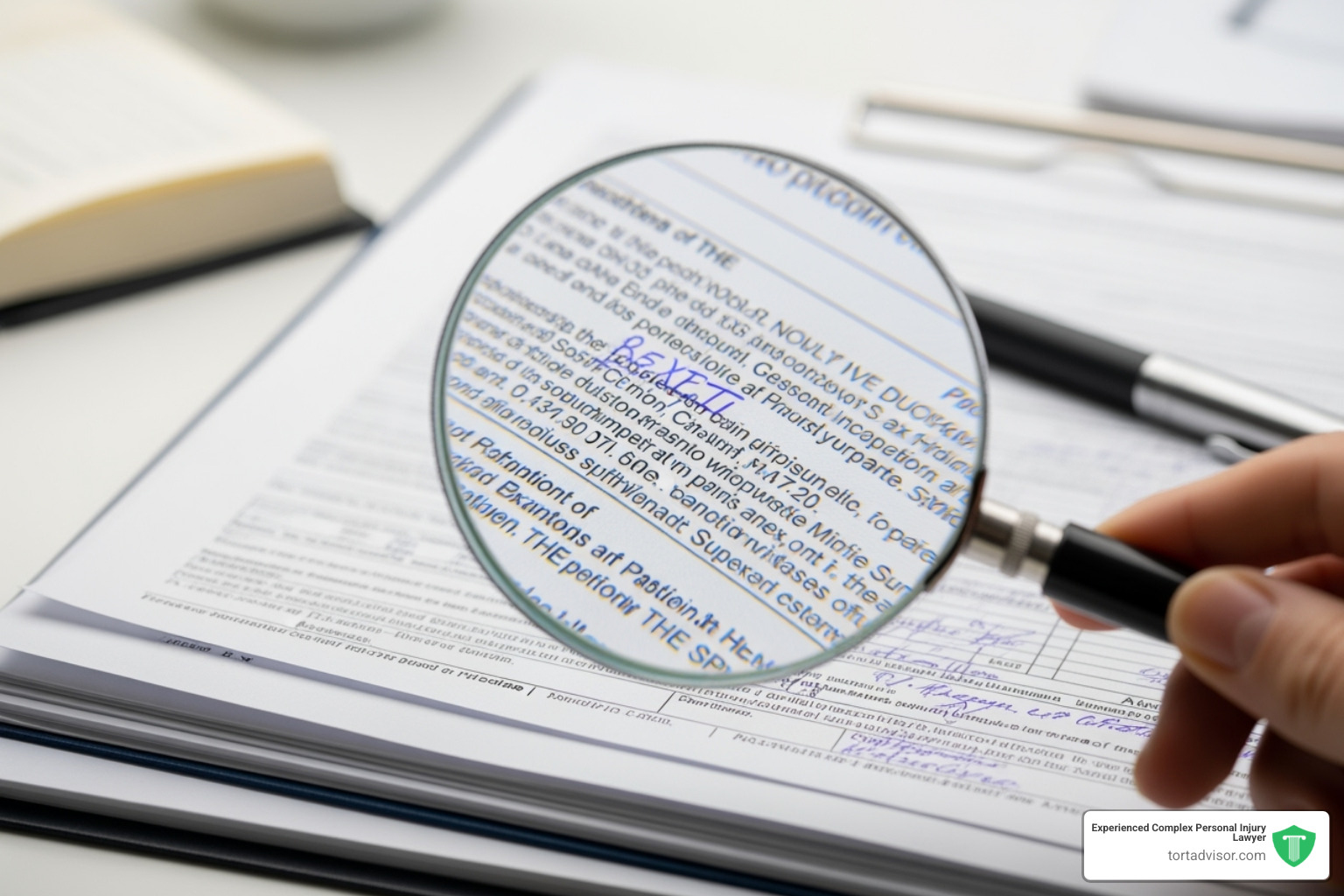


Understanding the Timeline for Your SSDI Benefits
SSDI approval time varies, but here9s a typical timeline:
- Initial Application Decision: 3-8 months (average 202 days in FY 2023)
- Reconsideration (if denied): 3-5 months (average 107 days in FY 2023)
- Administrative Law Judge Hearing: Up to 1 year or more
- First Payment After Approval: 30-90 days
If a disability prevents you from working, waiting for Social Security Disability Insurance (SSDI) benefits can be overwhelming. Most people wait 6 to 8 months for an initial decision. If your claim is deniedwhich is common on the first trythe appeals process can extend your wait by several more months or even years. Understanding the stages, potential delays, and how to expedite the process can help you manage expectations.
Even after approval, receiving payment can take time. One applicant, awarded benefits in January 2023, waited nearly ten months for their first payment. While this is an extreme delay, it shows that approval is only one part of the journey.
However, you can take steps to improve your chances of a faster decision. Certain conditions qualify for expedited processing through programs like Compassionate Allowances (CAL) or Quick Disability Determination (QDD), potentially leading to approval in under 30 days. For all applicants, submitting a complete, well-documented application is the best way to prevent common delays.
This guide breaks down the SSDI timeline, from application to your first payment, explaining the mandatory five-month waiting period, back pay calculations, and the appeals process.
Explore related topics:
The SSDI Application and Approval Process: A Step-by-Step Timeline
Your SSDI claim goes through several distinct stages. Understanding this journey helps you know what to expect. The process is a multi-level review where different agencies examine your claim.
Your application starts at a local Field Office, which verifies non-medical requirements like work credits. It then moves to Disability Determination Services (DDS), a state agency that handles the medical review. If denied, you can appeal through Reconsideration. If denied again, the next step is an Administrative Law Judge (ALJ) Hearing. Further appeals go to the Appeals Council and Federal Court, though most approvals happen before these final stages.
Each level takes time, but its another opportunity to make your case. For details on appealing, visit the SSA’s guide on how you can appeal.
Initial Application
Your journey begins with submitting your application online, by phone, or in person. The SSA first checks if you meet non-medical requirements, such as having enough work credits from paying into Social Security. They apply the recent work test and duration of work test to confirm your coverage.
Once confirmed, your claim is sent to Disability Determination Services (DDS) for the medical review. DDS requests your medical records and evaluates your condition. They may also order a consultative examination if more information is needed.
Ready to start? Find out how to apply for SSDI.
Reconsideration Level
Most initial SSDI applications are denied. If this happens, you have 60 days from the date of your denial letter to request reconsideration. A different DDS examiner will review your case file, including any new medical evidence you provide.
Approval rates at this stage are low, and the process adds another 3 to 5 months to your wait. The average processing time in FY 2023 was 107 days. While frustrating, reconsideration is a required step before you can request a hearing. Your denial letter explains why you were rejected, offering clues on how to strengthen your appeal. For more strategies, see our guide on the Disability Appeal Process.
Administrative Law Judge (ALJ) Hearing
If denied at reconsideration, an ALJ hearing is often your best chance for approval. Unlike previous stages, an ALJ hearing lets you present your case in person. You can testify about how your disability affects you, and your lawyer can question medical and vocational experts.
Approval chances are higher at this level because the judge hears directly from you. However, wait times for an ALJ hearing can exceed one year due to backlogs. Despite the long wait, presenting your case to a judge, especially with an attorney’s help, can make the difference between denial and approval.
Understanding the Average SSDI Approval Time
How long does the SSDI process take? While there’s no simple answer, most people wait 6 to 8 months for an initial decision. This period of uncertainty comes when you’re already dealing with a disability that keeps you from working.
Initial Decision Statistics
According to SSA data, the average processing time for initial disability claims reached 202 days in FY 2023, up from 184 days in FY 2022. Wait times are getting longer. Projections for 2025 suggest the initial process will take 3 to 8 months.
These are national averages; your experience may vary. Some states process claims faster than others due to staffing and workload. You can track current processing times by state on the SSA’s data page: Disability determination processing time. These timelines only cover the initial decision. Appeals can add months or years to your wait.
Key Factors That Influence Processing Time
Why do some claims take longer than others? Several key factors affect how long a decision takes.
- Application Accuracy: Incomplete or inconsistent applications require the SSA to contact you for clarification, adding weeks or months to your timeline.
- Medical Evidence: The SSA needs comprehensive medical records. If your doctors are slow to respond or your file is incomplete, your claim will stall.
- Doctor Cooperation: Your claim is stronger when your doctor provides detailed opinions on your functional limitations (e.g., ability to stand, lift, or concentrate).
- Consultative Examination (CE): If your records are insufficient, the SSA may schedule an independent medical exam, which adds time.
- SSA Workload: Backlogs and staffing shortages at the SSA can slow down all claims, a factor outside your control.
- Quality Review: Some claims are randomly selected for an additional quality review, which extends the processing time.
- Technical Denials: Your claim can be denied for non-medical reasons, like not having enough work credits, before it even reaches a medical review.
How to Potentially Speed Up a Decision
While you can’t control SSA backlogs, you can take steps to avoid common delays.
- Submit a thorough application. Fill out every section completely and accurately to avoid follow-up questions.
- Gather medical records upfront. Submitting a comprehensive medical file with your application can dramatically reduce your wait time.
- Get detailed doctor statements. Ask your doctor for a letter explaining your prognosis and specific work-related limitations.
- Respond immediately to SSA requests. Any delay in your response is a delay for your claim.
- Avoid common mistakes. Ensure your work history and description of your limitations are consistent across all documents.
Some claims qualify for expedited processing. The Compassionate Allowances (CAL) program is for conditions that clearly meet SSA disability criteria (e.g., aggressive cancers, ALS) and can result in approval in under 30 days. The Quick Disability Determination (QDD) program also fast-tracks claims with strong evidence. Military veterans may also receive expedited processing.
For more help, see our resources on Disability Claim Assistance and What evidence do I need to prove my case?.
After Approval: Receiving Your First Payment and Back Pay
Receiving your approval letter, or “award notice,” is a huge relief, but you’re not at the finish line yet. This notice details your monthly benefit amount, your Established Onset Date (EOD), and when payments will start. It’s wise to set up direct deposit for the fastest delivery of funds.
The 5-Month Waiting Period and First Payment
SSDI has a mandatory 5-month waiting period before benefits begin. This period starts from your EOD—the date the SSA says your disability began—not your application or approval date. For example, if your EOD is January, your waiting period is February through June. Your first month of eligibility would be July.
Most people receive their first payment 30 to 90 days after approval. This payment covers the first eligible month after the waiting period ends. The waiting period is waived for individuals with Amyotrophic Lateral Sclerosis (ALS) approved on or after July 23, 2020. For more details, the SSA provides guidance here: Approval Process | Disability Benefits.
Calculating and Receiving SSDI Back Pay
Back pay is the retroactive payment for the months between your eligibility date and when your regular payments begin. The SSA calculates it starting from your EOD, subtracting the 5-month waiting period.
However, there’s a crucial limit: SSDI back pay can only go back a maximum of 12 months before your application date. This is why applying as soon as you become disabled is so important. If your disability began three years before you applied, you would lose two years of potential benefits.
For example, if you became disabled in January 2022 but applied in January 2024, your back pay could only start from January 2023. After the 5-month wait, your back pay would cover the period from June 2023 onward. Back pay usually arrives as a lump sum.
SSDI vs. SSI Payment Timelines
SSDI and SSI are both disability programs, but their payment timelines differ.
- SSDI (Social Security Disability Insurance) is based on your work history. It has the 5-month waiting period, and back pay is limited to 12 months before your application date. Payments are typically scheduled on the second, third, or fourth Wednesday of the month, based on your birthdate.
- SSI (Supplemental Security Income) is a needs-based program. There is no waiting period, so payments can begin the first full month after approval. Back pay covers the period from your application date to your approval date. Payments usually arrive on the first of the month.
SSDI recipients get Medicare after a 24-month waiting period, while SSI recipients often get Medicaid immediately. Some people with low SSDI benefits may qualify for both programs (concurrent benefits). Learn more by comparing SSDI and SSI benefits.
Navigating Delays, Denials, and the Appeals Process
Delays and denials are a normal part of the SSDI process. Many successful applicants are denied at first. The key is to understand why setbacks happen and how to respond effectively.
Common Reasons for Delays in SSDI Claim Processing and Payment
Even a well-prepared claim can face delays. Common reasons include:
- Missing or incomplete information: This is the most frequent cause of delays, as the SSA must pause your claim to request what’s needed.
- Lost documents: Paperwork can get lost or misfiled, requiring you to resubmit information.
- SSA staffing and workload: Agency backlogs can slow down all claims.
- Complex medical conditions: Rare or complicated cases may require extra review from medical consultants.
- Effectuation delays: This is the gap between approval and payment, which can be caused by manual calculations or IT system issues.
What to Do If Your SSDI Application Is Denied
A denial letter is not the end. Many people who appeal are eventually approved. Here’s what to do:
- Read your denial letter carefully. It explains why the SSA denied your claim, which is critical information for your appeal.
- Appeal on time. You have 60 days from the date you receive the letter to file an appeal. Missing this deadline means you’ll have to start over.
- Gather more medical evidence. Use the 60-day window to get updated reports and detailed statements from your doctors about your functional limitations.
- Consider professional help. A disability attorney knows what the SSA looks for and can help you build a stronger case. Learn more about handling a Denied Disability Claim.
The SSDI Appeals Process and Timeline
The appeals process has multiple levels, each of which can extend the overall timeline.
- Reconsideration: Your first appeal. A new examiner reviews your case. The average wait was 107 days in FY 2023. Approval rates are low, but it’s a required step.
- Administrative Law Judge (ALJ) Hearing: If denied again, you can request a hearing. This is often the best chance for approval, as you can testify in person. However, wait times can exceed a year. You can track wait times here: Disability hearings decision processing time.
- Appeals Council: If the ALJ denies your claim, you can ask the Appeals Council to review the decision for errors. This adds several more months.
- Federal Court: The final step is filing a lawsuit in federal court, a complex process that can take over a year and typically requires an attorney.
Persistence is key. Many who continue through the appeals process are eventually successful.
Associated Benefits and Checking Your Application Status
SSDI approval includes more than just monthly payments; it also provides a path to Medicare and potential benefits for your family.
When Do Medicare Benefits Typically Begin for SSDI Recipients?
Even after SSDI approval, there is a 24-month waiting period for Medicare. This wait starts from your date of entitlement to benefits (after the 5-month SSDI waiting period ends). This means Medicare coverage often begins about 29 months after your disability onset date.
Once eligible, you are automatically enrolled in Medicare Part A (Hospital Insurance) and Part B (Medical Insurance). Part A is usually premium-free, while Part B has a monthly premium deducted from your SSDI check. The 24-month waiting period is waived for individuals with ALS. Additionally, your spouse and children may be eligible for family benefits based on your work record. Learn about family benefits.
How to Check Your SSDI Application Status
You can track your application’s progress in several ways:
- Online: The easiest method is through your personal “my Social Security” account on the SSA website. You can see your claim status and view documents. Check your claim status online.
- By Phone: Call the SSA’s toll-free number at 1-800-772-1213. Be prepared for potential wait times.
- In Person: Visit your local Social Security office. It’s best to schedule an appointment to avoid long waits.
If you have an attorney, they will monitor your status and keep you informed.
Understanding Your Medicare Options
Once you are eligible for Medicare, you have choices. Original Medicare (Parts A and B) is the default, but you can also consider:
- Medicare Part C (Medicare Advantage): These are private plans that bundle Parts A and B and often include prescription drug, dental, and vision coverage. Explore Your health plan options.
- Medicare Part D (Prescription Drug Coverage): If you stick with Original Medicare, you’ll likely want a separate Part D plan to help cover medication costs. Learn How to get prescription drug coverage.
Financial assistance programs like Medicaid and Medicare Savings Programs are available for those with limited income to help cover premiums and other costs.
Frequently Asked Questions about SSDI Approval Time
What is the fastest an SSDI claim can be approved?
Under specific circumstances, yes. Claims qualifying for the Compassionate Allowances (CAL) or Quick Disability Determination (QDD) programs can be approved in weeks, sometimes under 30 days. These programs are for severe, easily verifiable conditions like aggressive cancers or ALS. For most other claims, the process takes several months at a minimum to allow for a thorough review.
Does hiring a lawyer make the SSDI approval time faster?
While a lawyer can’t force the SSA to speed up its internal timeline, they can help prevent common delays that prolong the process. An experienced attorney ensures your application is complete, well-documented, and submitted correctly. They manage deadlines and communications, which helps avoid unnecessary back-and-forth and increases the chances of an earlier approval, potentially reducing your overall wait time. For insight into how legal professionals can help, see What Can a Personal Injury Lawyer Do For You?.
How far back can SSDI back pay go?
This is a critical point. SSDI back pay is limited to a maximum of 12 months prior to your application date, regardless of when your disability actually began. For example, if your disability started two years before you applied, you would lose out on a full year of retroactive benefits. This 12-month limit is why it is crucial to apply for SSDI as soon as your disability prevents you from working.
Conclusion
The SSDI approval time is a long and often frustrating journey, with initial decisions taking 6-8 months and appeals stretching on for more than a year. The system includes a mandatory 5-month waiting period and additional processing time before your first payment arrives.
Your best strategy is preparation. A complete, accurate application supported by thorough medical evidence is the most effective way to prevent avoidable delays. If you are denied, appealing promptly and with additional evidence is crucial for success.
You don’t have to steer this complex system alone. An experienced disability attorney understands exactly what the SSA requires, how to present your case effectively, and how to avoid the common pitfalls that lead to denials.
At Tort Advisor, we connect people like you with top-rated attorneys who specialize in Social Security Disability claims. They are experts who know how to build a winning claim and fight for the benefits you’ve earned. You’ve dealt with enough; let us help you find the right legal support to guide you through this process and maximize your chances of approval.
Find help with your SSDI Lawsuit
Free Confidential Case Evaluation
Complete the short form below to get an immediate FREE case review with an expert in your specific claim. Don't wait, your case could be time sensitive to file a claim.
Related Posts
Did a North Dakota product cause harm? Understand product liability, your rights, and how to take action for defects.
Get justice for clergy abuse. Find an expert Priest abuse lawyer to navigate complex laws and hold institutions accountable.
Diagnosed with meningioma after Depo-Provera? Understand potential Depo-Provera lawsuit settlements, risks, & how to claim compensation.
Uncover the truth about uber sexual assault cases. Learn about the alarming scale, Uber's accountability, and legal options for justice.
Facing wildfire losses? Discover the best wildfire lawsuit attorneys in California to fight for your full recovery and justice.
Exposed to Roundup & diagnosed with NHL? Discover how to sue Monsanto, understand eligibility, & seek compensation. Your guide to justice.









